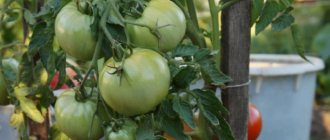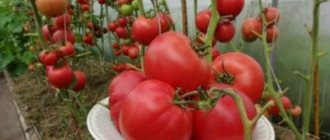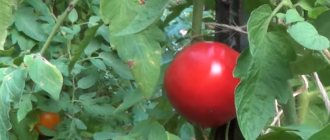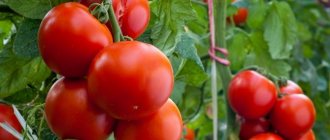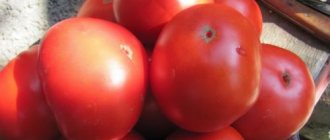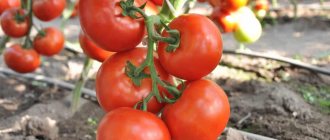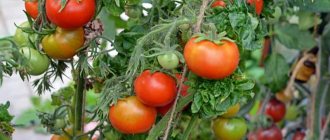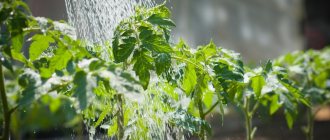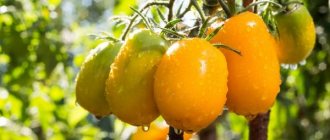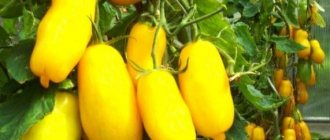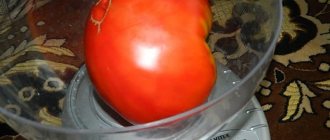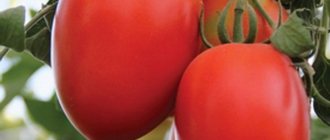Mid-season tomato varieties are very popular on the market. The Roma tomato is a vegetable crop, the ripening period of which lasts only 110-120 days, is quite unpretentious in care, and has a number of differences and advantages.
The Roma tomato variety is especially popular in Italy and is often in demand among Australians. Also, Roma tomatoes are very popular in Russia. The versatility in use and ease of growing have not left any summer resident indifferent.
Roma tomatoes are the painstaking work of breeders from Holland. The variety is new. Sweet mid-season tomatoes can provide a bountiful harvest with minimal care.
Description of Roma tomato
The determinate variety of Roma tomatoes is most often grown in the south of Russia. But if you try to plant it in another region, you can also get a good harvest. However, most importantly, the crop must grow in warm and sunny weather.
If you want to plant Roma tomatoes in an area with a cool climate, summer residents recommend doing this in greenhouses or greenhouses.
The Roma tomato variety is mid-season and has small tops. The maximum height of the plant is 1 m. Due to the compactness of the bush per 1 sq. m summer residents plant up to 7 seedlings.
Attention! The period of seed ripening before fruiting is only 110-120 days.
Description of fruits
A description of the Roma tomato variety is necessary for familiarization before choosing a crop for planting. Tomatoes are ovoid in shape, reminiscent of the Slivka variety. The pulp is quite compacted and has high sugar levels. The weight of one tomato is from 70 to 85 g. The color of the fruit is deep red.
Features of care
Although Roma tomatoes are not tall, it is better to plant them. This will increase the number of larger fruits. If you leave a lot of shoots, then pea tomatoes will be collected. It is enough for a plant to form 3, less often 5, stems, and it is better to cut off the extra shoots when the shoots reach a length of 3–5 centimeters. But the variety does not require garter.
See also
Description of the Hugo tomato, growing a hybrid variety in seedlings and further care
Read
Feed tomatoes with Roma VF every 2–3 weeks, pouring 1 liter of nutrient solution onto the bush.
Fertilizers for tomatoes need both organic and mineral. Start with a solution of mullein or chicken droppings. Then comes the turn of superphosphate, potassium salt, and ammonium nitrate. The substances are dissolved in 10 liters of water. The amount of fertilizer depends on the stage of development of the vegetable crop. At the initial stages, 15–20 grams of potassium and nitrogen fertilizers are sufficient. But tomato constantly needs phosphorus, so superphosphate is needed 2-3 times more than other fertilizers.
The productivity of a tomato variety depends on watering, loosening and weeding. Plants grown in a greenhouse require control of humidity and air temperature. Tomatoes are uncomfortable in 30-degree heat. The fruit set will be weak, so you need to pay attention to the ventilation of greenhouse areas. Humidity should be within 80 percent.
Characteristics of the variety
Roma tomato seeds are produced in Holland. In Russia, unfortunately, they do not produce them independently. But due to the fact that the crop is in great demand, such tomatoes can be purchased at a garden store.
Productivity and fruiting
Mid-season Roma tomatoes are very convenient to plant in the garden. Thanks to its miniature size and non-spreading tops per 1 sq. m you can plant up to 7 bushes. Tomato variety Roma f1 produces 1.5 kg of fruit per plant. From 1 sq. m you can collect more than 12 kg. The first harvest appears 3 months after planting.
Unfavorable weather conditions can affect crop yields. The Roma tomato variety loves warm weather, so before planting you should think about the possibility of providing proper care.
Area of application of fruits
Tomato variety Roma is not for everyone. The fruits are quite sweet, but with dense pulp, not juicy, and a little tight. However, some summer residents speak of Roma tomatoes as the best for freezing and winter preservation.
The main advantage of the Roma tomato variety is the preservation of beneficial properties even after long-term freezing. Therefore, they can be harvested for the winter to prepare fresh salads.
Attention! When frozen, the fruits do not drain with water. This is due to the compacted structure.
Resistance to diseases and pests
This variety has good immunity against fungi and infections, however, if not properly cared for, it can be affected by late blight or gray rot. To avoid hassle with treating diseases, it is necessary to follow the correct agricultural practices for planting and caring for vegetables. Just a few important steps can make growing it a pleasure.
Advantages and disadvantages of the variety
The Roma tomato variety has positive qualities, after studying which many people focus on them.
Advantages:
- not troublesome to grow and care for;
- resistant to diseases;
- compactness when placed on the garden bed;
- high productivity;
- long harvest time. The tomato bears fruit until the first frost;
- tolerate transportation well;
- high content of sugar and nutrients.
Among the disadvantages, it is worth noting that Roma tomatoes do not like high humidity in the soil.
Advice! Roma tomato should be provided with moderate watering in the morning or evening.
Pests and diseases
The cultivation of determinants is marred by diseases when conditions that are “favorable” for infection agents are created: high humidity with changes in air temperature. It is noted that at this time symptoms may appear on the leaves and stems of the Roma tomato:
- late blight;
- streaky tomato;
- curling leaves.
Late blight is contracted at the end of the growing season. This is why the disease is dangerous, since you can lose the entire harvest. To avoid misfortune, you need to spray the tomato plantings with a solution of Bordeaux mixture three times during the summer.
See also
Characteristics of tomato Swat f1 and description of growing variety
Read
Symptoms of streaking include curling of the leaves, dark spots, fragility and brittleness of the stem. Infection occurs either from seeds or from diseased plants during pinching.
When a tomato leaf takes the shape of a tube, this indicates a lack of phosphorus in the plants. The fungus is activated by low air humidity and untimely removal of stepsons.
Among the pests that damage the leaves of tomatoes are the beetle and its larvae. Plants can be freed from the parasite by collecting beetles manually or by treating them with insecticidal preparations. In greenhouses, vegetable leaves are eaten by earwigs and woodlice. To prevent pests from causing damage, it is necessary to remove excess shoots in a timely manner.
Growing rules
When planting the Roma tomato variety, it is important to observe crop rotation. Places where zucchini, cucumbers or carrots grew will be the best predecessors.
Important! Roma tomatoes should be planted using the seedling method. Planting seeds directly into the soil will not produce good germination.
Planting seedlings
The basic rules for growing sprouts are the following agricultural techniques:
- using a soil mixture with the addition of ash and humus. A prerequisite is its calcination in the oven for disinfection;
- if it is impossible to prepare the soil yourself, you can purchase ready-made soil in a special store;
- after preparing the substrate, the soil is placed in seedling boxes with drainage holes;
- the soil is well moistened and compacted tightly;
- make indentations of 1 cm at intervals of 5-6 cm;
- Sow seeds in the holes and water a little.
It is worth noting that before planting seeds, they should be disinfected. It will be enough to soak the seed in a saline solution. Seeds that float must be thrown away as they will not sprout.
You can also carry out special treatments with the preparations “Ideal”, “Epin” or “Stimul”.
Attention! If the seeds from the package have a protective shell, they do not need to be processed.
After sowing the seeds, the box with seedlings must be covered with a transparent film and left in a warm place until the sprouts hatch. As soon as the seedlings sprout, remove the film and place the sprouts in a lighted place. A window sill would be an excellent option.
Important! It is necessary to protect tomatoes from drafts and sudden changes in temperature.
Picking
When the seedlings have 2-3 leaves, pick the plants. Seedlings are dropped into separate 0.7 ml cups. You can plant seeds directly in separate containers, then the plant does not need picking.
Advice! Only strong and healthy seedlings should be replanted.
Transfer
The soil for planting tomatoes must be prepared in advance. In the fall, the soil is dug up and fertilizing is applied. The Roma tomato variety loves fertile and loose soils. If planting is carried out in a greenhouse, the soil must be replaced. The top 15 cm layer is replaced with fresh soil.
Roma tomatoes are planted as seedlings in mid-March. By the end of May, the sprouts will stretch out and become stronger, then you can begin replanting to a permanent place.
Before transplanting seedlings to a garden bed or greenhouse, you should make small depressions in the soil. The size of the holes should be equal to the size of the root system of the seedlings. After planting, the sprouts are sprinkled with soil and watered well.
Bush formation
During the growth process, it is necessary to form a bush into 1 stem, but this is only if it is planted on 1 square meter. 7 sprouts. When formed into 2 or 3 trunks, per 1 sq. m there are fewer plants - up to 6 seedlings.
Aftercare
Caring for Roma tomatoes is quite simple. It is better to plant tomatoes in greenhouse conditions or in the southern environs. The measures consist of implementing the following recommendations:
- Stepsonning. During the growth process, it is necessary to remove unnecessary stepsons. During this period, a plant with 1 or 2 stems begins to form.
- Water every 3 days. Weather conditions should be taken into account. In rainy weather, watering should be reduced; in sunny weather, water early in the morning or in the evening.
- Spray the tops with a spray bottle. Do it in the morning or evening so that the sun does not burn the tomato leaves.
- Water the crop carefully at the root.
- Add regular fertilizing. Make the first application of fertilizers with the addition of nitrophoska and mullein. The second feeding should be done with chicken manure, superphosphate and potassium sulfate.
- Before fruiting, add nitrophoska and potassium humate to the soil.
Attention! Don't forget that tomatoes don't like to be overgrown with weeds. It is necessary to regularly remove unwanted vegetation.
How to properly harden and pick a tomato?
Immediately before planting, tomato seedlings must be hardened off for 7 days.
To do this, in the room in which the tomato seedlings are located, you need to reduce the air temperature using an air conditioner to 9 degrees Celsius. As an alternative for hardening, tomato seedlings can be taken outside for several days during the daytime. At the beginning of hardening, the seedlings should be taken outside for a short time (5-10 minutes). Then the period of the plant being outdoors should be gradually increased from several minutes and hours up to a full daylight hours. When evening comes, the seedlings must be transferred back indoors.
Growing tomatoes using the so-called picking method involves the use of special boxes made of wood. Such boxes can be made independently at home or purchased in special stores. When the first leaves begin to appear on tomato seedlings, they are planted in boxes.
The distance between the rows of planted bushes must be at least 10 cm, and the distance between plants planted in the same row must be at least 6 cm. It is worth noting that for diving, instead of wooden boxes, you can actively use special peat pots. The minimum volume of one such pot into which one tomato bush can be transplanted should be at least one liter.
Low-growing Roma tomatoes can even be grown on a windowsill
The Roma tomato is suitable for those who like to prepare thick tomato sauces and juices. Due to its firm texture and rich flavor, this variety is often used in cooking and is especially suitable for drying. This tomato is self-pollinating and compact in size, so it is often chosen for growing on a windowsill.
Despite the fact that the birthplace of this tomato is the United States of America, more and more domestic vegetable growers are planting it in their beds. The seed supplier is Holland.
Diseases and prevention
The hybrid is not afraid of fusarium and verticillium, but is vulnerable to late blight and other fungal diseases. He does not tolerate increased dampness and easily gets sick in such conditions. For prevention, it is necessary to avoid overmoistening, regularly ventilate the greenhouse, and mulch the soil with hay or straw, which additionally regulates the level of humidity. Preventive spraying with preparations containing copper, Bordeaux mixture or Fitosporin works well.
The most dangerous parasites for tomatoes are the Colorado potato beetle, aphids, mole crickets, whiteflies and slugs. Against the latter, you can sprinkle the soil on the site with mustard and hot pepper - 1 teaspoon of a mixture of powders per 1 square meter. m. Crushed eggshells are also suitable. To remove aphids and spider mites, carefully wash the leaves with a soapy solution. Whiteflies can be repelled by placing marigolds, basil or tobacco between the tomato rows. The Colorado potato beetle is collected by hand, and in case of severe infestations, pesticides are used.
Transplanting seedlings into the ground
Roma tomatoes are replanted at the age of two months after eight leaves appear on the stem.
Transplanting seedlings into the ground is possible only after a period of return frosts has passed. For the south of Russia this is from the beginning to mid-May, in the central part of the country - the end of May to mid-June.
Planting pattern – 40x50 cm or more. 6 bushes per m² are enough.
Before transplanting into the ground, it is recommended to harden the plant: take the seedlings outside for several hours, reduce the temperature in the room, and ventilate. Watering should be done exclusively with water at room temperature or slightly higher.
Useful care tips
The Roma variety is highly resistant to heat and drought, which is why it is popular in the southern regions. Its peculiarity is that plants are more demanding of good lighting. In cloudy and rainy weather, fruits set worse, leaves wither, and plants are more susceptible to fungal diseases.
This variety of tomato can be planted in any type of soil, except heavy (clayey). It has been noticed that higher yields can be obtained by planting bushes in well-fertilized loamy and sandy loam soil.
Crop rotation
Successful predecessors are carrots, all types of cabbage, beans, cucumbers, and onions. Not bad ones are corn, rutabaga, onions, garlic, strawberries, beets, rapeseed, rye and other cereals, sunflowers, lawn grasses. All nightshades are not suitable as precursors: potatoes, sweet and bitter peppers, physalis, eggplant, nightshade, tobacco. Some gardeners argue: “I’ll plant it in any free space, something will grow anyway.” This should not be done: diseases and pests of the predecessor, if they are the same as those of tomatoes, can destroy the entire crop.
During the period of intensive growth of leaf mass, the bushes are fed with nitrogen fertilizer, during the formation of fruits - complex, prepared on the basis of mullein (10 l), ash (2 kg), nettle leaves (5 buckets), yeast (2 kg) and whey (3 l) .
All components are placed in a barrel, filled with an arbitrary amount of water so that it covers the raw materials, and left for 2 weeks. Then add a little water again and pour 1 liter of fertilizer under each bush. Reviews prove that this is the best comprehensive nutrition.
Further care involves preventing late blight. Otherwise, the activities are the same as for growing other varieties of tomatoes.
Productivity
Although the bushes are not tall and the fruits are not particularly large, this variety is surprisingly quite productive, especially under growing conditions of up to 6 bushes per square meter. In this case, you can collect about 12 kilograms of crop.
Which regions are best to grow in?
The tomato is quite heat-loving and grows well in the open ground of the southern regions of Russia, but bushes can also be grown under film covers in regions with slight temperature changes in the summer. In greenhouse conditions, tomatoes can be grown anywhere.
Advantages and disadvantages of the variety
- The variety has a lot of advantages, which is why it is so highly valued by vegetable growers:
- Large and fleshy fruits.
- Productivity.
- It's enough just to walk through.
- Tastes good.
- Resistance to a number of diseases.
The variety has no particular disadvantages, as minor disadvantages can only be noted that it requires tying and pinching, however, these are fairly standard care rules for many varieties.
Sources
- https://MoeFermerstvo.ru/tomat/vyrashhivanie/rim
- https://repka.online/ovoshhi/tomaty/rannespelyie/sluzhebnyiy-roman.html
- https://otomate.ru/rim.html
- https://openfile.ru/dacha-i-sad/%D1%82%D0%BE%D0%BC%D0%B0%D1%82-%D1%81%D0%BB%D1%83%D0% B6%D0%B5%D0%B1%D0%BD%D1%8B%D0%B9-%D1%80%D0%BE%D0%BC%D0%B0%D0%BD-%D0%BE%D0% BF%D0%B8%D1%81%D0%B0%D0%BD%D0%B8%D0%B5-%D0%B8-%D1%85%D0%B0%D1%80%D0%B0.html
- https://repka.online/ovoshhi/tomaty/srednespelyie/roma-f1.html
- https://rusfermer.net/ogorod/plodovye-ovoshhi/tomat-pomidor/srednespelye-sorta/roma.html
- https://teplichniku.ru/pomidory/universalnyi-tomat-roma-kharakteristika-i-opisanie-sorta/
- https://MoeFermerstvo.ru/tomat/uhod/sluzhebnyj-roman
- https://profermu.com/ogorod/pomidory/sorta-p/roma.html
- https://DachaDecor.ru/ogorod/tomati-roma-opisanie-sorta-i-rekomendatsii-po-viraschivaniiu
